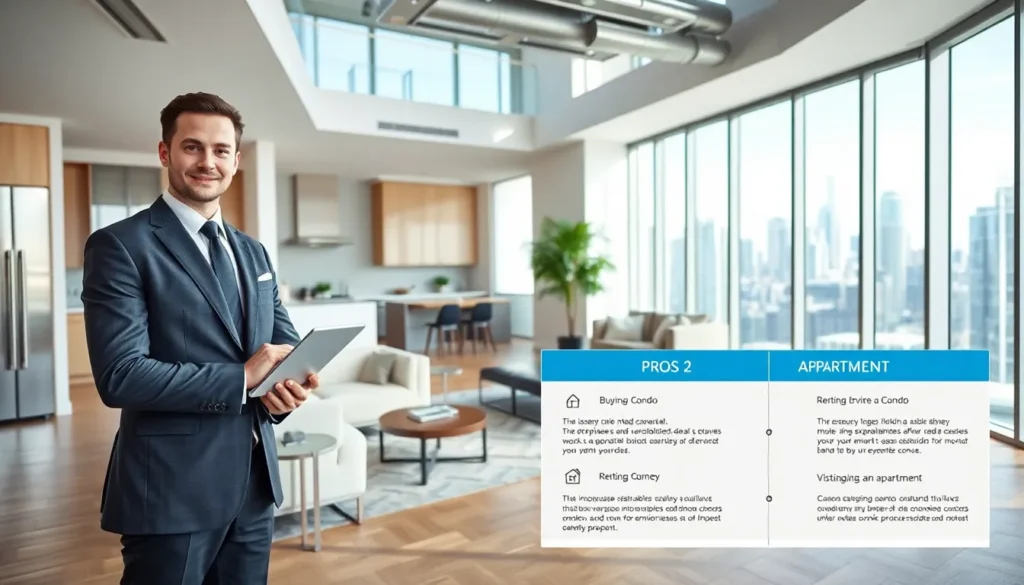Table of Contents
ToggleNavigating the renting process can feel overwhelming, especially for first-time renters. From understanding lease agreements to dealing with security deposits, each step requires careful consideration. Knowing the ins and outs of renting can make the experience smoother and less stressful.
In today’s competitive rental market, having a solid grasp of the process is crucial. Whether it’s finding the right property or negotiating terms, being informed empowers renters to make the best decisions. This article breaks down the key components of renting, providing essential tips and insights to help renters secure their ideal home with confidence.
Understanding the Renting Process
Understanding the renting process is crucial for first-time renters. This process involves several key steps that facilitate successful property acquisition.
1. Researching Properties
Researching properties helps identify suitable options. Renters should consider aspects such as location, amenities, and rental rates. Websites like Zillow and Rent.com offer comprehensive listings to aid in this research.
2. Viewing Properties
Viewing properties plays a critical role in decision-making. Renters should schedule visits to assess the condition of the home. Observing both the interior and exterior provides insights into the living environment.
3. Understanding Lease Agreements
Understanding lease agreements enables renters to comprehend their obligations. A lease outlines terms, including the rental amount, payment due dates, and maintenance responsibilities. Reviewing this document thoroughly is essential before signing.
4. Negotiating Terms
Negotiating terms can lead to favorable renting conditions. Renters may discuss aspects like rental price, lease duration, or included utilities. Clear communication with landlords is key during negotiations.
5. Managing Security Deposits
Managing security deposits requires attention to detail. A security deposit typically equals one month’s rent and secures the property against damages. Renters should document the property’s condition before moving in to avoid disputes later.
6. Finalizing the Agreement
Finalizing the agreement involves signing the lease and paying the initial deposit. Renters must ensure all terms discussed are included in the agreement. Keeping a copy of the signed lease for reference is important.
This understanding of the renting process empowers renters to navigate the market effectively, facilitating informed decisions and enhancing the likelihood of securing a suitable home.
Key Steps in the Renting Process

Renters must follow several key steps to navigate the renting process successfully. These steps ensure a thorough understanding of available properties and the necessary actions to secure a lease.
Finding the Right Property
Finding the right property begins with extensive research. Renters should consider factors such as location, amenities, and rental rates. Online platforms, real estate websites, and local listings provide valuable insights. Comparing multiple options helps identify what suits specific needs best. Scheduling property viewings allows renters to assess conditions and gauge the fit for their lifestyle. Inspecting for maintenance issues, layout suitability, and neighborhood conditions strengthens decision-making. Leveraging recommendations from trusted sources can also lead to favorable options.
Application Process
The application process requires diligence and organization. Renters should gather necessary documents, including proof of income, identification, and references. Completing the rental application accurately is crucial, as errors can cause delays. Some landlords ask for background checks, which verify credit history and rental background. Preparing for interviews with potential landlords helps convey reliability and intent. Responding to applications promptly demonstrates commitment and interest. Understanding application fees and potential deposits is essential to avoid surprises. Ensuring all required materials are submitted increases the chances of securing the chosen property.
Lease Agreements
Lease agreements serve as contracts between landlords and tenants, detailing their rights and responsibilities. Understanding these agreements is essential for a successful renting experience.
Important Terms to Know
- Rent: The monthly payment due for occupying the property, typically specified alongside the due date.
- Security Deposit: An amount collected by landlords to cover potential damages or unpaid rent. Familiarize yourself with the conditions for its return.
- Lease Duration: The period for which the lease is valid, whether it’s a fixed-term lease (e.g., one year) or a month-to-month agreement.
- Maintenance Responsibilities: A clause that outlines who is responsible for repairs and upkeep of the property.
- Termination Clause: Conditions allowing either party to end the lease before its expiration, including notice periods and penalties.
- Late Fees: Charges imposed for rent payments made after the due date, typically outlined to avoid confusion.
Negotiating the Lease
Negotiating lease terms can lead to better conditions for renters. Focus on the following strategies:
- Start with Essentials: Identify critical terms such as rent amount and lease duration to address during negotiations.
- Ask for Improvements: Propose necessary repairs or upgrades before signing, as many landlords may agree to maintain their properties.
- Request Flexibility: Seek flexible lease terms, like the ability to sublet or making arrangements for early termination under specific circumstances.
- Compare Offers: Reference competing rental properties to strengthen rent negotiations, showing landlords the market rates for similar units.
- Document Everything: Ensure all negotiated terms are included in the final lease agreement to safeguard both parties’ interests.
Understanding lease agreements and effectively negotiating terms equips renters with the tools needed to secure favorable living conditions.
Moving In
Successfully moving into a new rental property requires careful planning and execution. Two critical steps involve preparing for move-in day and setting up utilities.
Preparing for Move-In Day
Preparing for move-in day involves creating a checklist of essential tasks. Organizing belongings ensures a smoother transition.
- Confirm Move-In Date: Verify the agreed-upon move-in date with the landlord to avoid any misunderstandings.
- Schedule Movers or Transportation: Book a moving company or rental truck well in advance to ensure availability.
- Pack Efficiently: Use appropriate packing materials to safeguard items. Label boxes for easy identification at the new property.
- Inspect the Property: Before moving in, conduct a thorough walkthrough of the property to confirm its condition matches expectations. Document any discrepancies.
Setting Up Utilities
Setting up utilities is vital for a comfortable living experience. Timely arrangements help avoid interruptions in essential services.
- Research Utility Providers: Identify local providers for electricity, gas, water, internet, and cable services.
- Contact Providers Early: Initiate service requests at least two weeks before the move-in date to ensure that utilities are active upon arrival.
- Gather Necessary Information: Have documentation, such as identification and proof of residency, ready for utility setup.
- Schedule Installation Appointments: Arrange for installation of services, considering that some providers may require on-site visits.
By following these steps, renters can ensure a smooth move-in process and establish essential services seamlessly.
Navigating the renting process can be daunting for first-time renters. However with the right knowledge and preparation it becomes a manageable task. Understanding lease agreements and effectively negotiating terms can lead to a favorable renting experience.
By staying organized and diligent throughout the application process renters can significantly improve their chances of securing their ideal home. Careful planning for the move-in process further ensures a smooth transition.
Arming themselves with these insights allows renters to approach the market confidently and make informed decisions that align with their needs and preferences.




